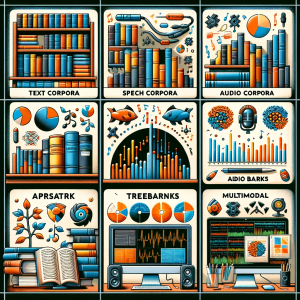
At the heart of NLP lies a fundamental element: the corpus. A corpus, in NLP, is not just a collection of text documents or utterances; it’s at the core of large language models (LLMs) training. Each corpus type serves a unique purpose in terms of training language models that serve different purposes. Whether it’s a collection of written texts, transcriptions of spoken words, or an amalgamation of various media forms, each corpus type holds the key to leveraging different aspects of language to generate value.
In this blog, we’re going to explore the significance of these different corpora types in NLP. From the traditional text corpora consisting of written content to the speech corpora, from the linguistically diverse parallel corpora to the structurally intricate treebanks, and the integrative multimodal corpora – each plays a pivotal role in how we teach machines to understand and generate human language.
Text Corpora
Text corpora encompass a vast array of written materials including books, scholarly articles, web content, emails, and social media posts. This extensive collection is crucial in providing varied and comprehensive linguistic data. Here are some example use cases of text corpora:
- Language Modeling: Large Language Models (LLMs) like OpenAI’s GPT series are trained on extensive and diverse text corpora, encompassing a wide range of internet text, books, articles, and other written material. This comprehensive dataset is crucial for their ability to understand and generate human-like text across various topics and styles.
- Sentiment Analysis: Businesses analyze customer reviews or social media posts to gauge public sentiment about products or services.
- Text Classification: News agencies use text corpora to categorize articles into topics like sports, politics, or entertainment.
- Information Retrieval: Search engines like Google use text corpora to refine search algorithms, helping users find relevant information efficiently.
Text Corpus Examples
The following examples are some commonly used text corpus:
- Common crawl: Vast web corpus collected by crawling the Internet
- Wikipedia
- BooksCorpus: Contains more than 11,000 books, totaling about 5 billion words, from diverse genres and subjects
- OpenSubtitles: Contains subtitles from movies and TV shows
- WebText: Used by OpenAI for GPT-2
- Toronto Book Corpus (Similar to BooksCorpus but contains different books)
- English Gigaword (Newswire text data)
- Stanford Question Answering Dataset (SQuAD): Contains passages from Wikipedia and associated questions, apart from regular questions and answers
- Microsoft MAchine Reading COmprehension Dataset (MS MARCO): Contains real-world questions and answers
- Common datasets for translation tasks
- LM1B
Speech Corpora
Speech corpora are collections of audio recordings of spoken language, which may also include their transcriptions. They offer a rich resource for understanding various accents, dialects, and nuances of spoken language. Here are a few example use cases of speech corpora:
- Speech Recognition: Voice assistants like Amazon’s Alexa or Apple’s Siri are trained on speech corpora to understand various accents and speaking styles.
- Speaker Identification: Security systems use voice biometrics for identification and authentication purposes.
- Emotion Detection: Call centers use speech corpora to detect customer emotions and improve service quality.
Parallel Corpora
Parallel corpora contain texts in multiple languages, meticulously aligned at the sentence or document level for cross-lingual comparisons. Here are a few example use cases of parallel corpora:
- Machine Translation: Services like Google Translate and DeepL use parallel corpora to train their translation algorithms.
- Cross-Lingual Tasks: Research in cross-lingual information retrieval and text categorization often relies on parallel corpora for training models.
Treebanks
Treebanks are annotated databases where the syntactic parse trees of sentences are meticulously detailed, elucidating the complex grammatical structures of language. Here are a few example use cases for treebanks:
- Parsing: Software for natural language understanding uses treebanks to improve the accuracy of parsing sentences.
- Syntax-Based Machine Learning: Linguistic research and advanced language models use treebanks to understand complex sentence structures.
An example of a text corpus based on Treebanks is Penn Treebank. Contains tagged, parsed, and raw Wall Street Journal data.
Multimodal Corpora
Multimodal corpora integrate text with other forms of data, such as images, videos, or audio, creating a rich, multi-layered dataset. Here are a few example use cases of multimodal corpora:
- Image Captioning: AI models learn to generate descriptive captions for images, aiding in accessibility for visually impaired users.
- Video Analysis: AI in media production uses multimodal corpora to automate video editing by analyzing and syncing audio with relevant video segments.
- Audio-Visual Speech Recognition: Systems like lip-reading AI are developed using multimodal corpora to understand speech in noisy environments.
- Three Approaches to Creating AI Agents: Code Examples - June 27, 2025
- What is Embodied AI? Explained with Examples - May 11, 2025
- Retrieval Augmented Generation (RAG) & LLM: Examples - February 15, 2025
I found it very helpful. However the differences are not too understandable for me